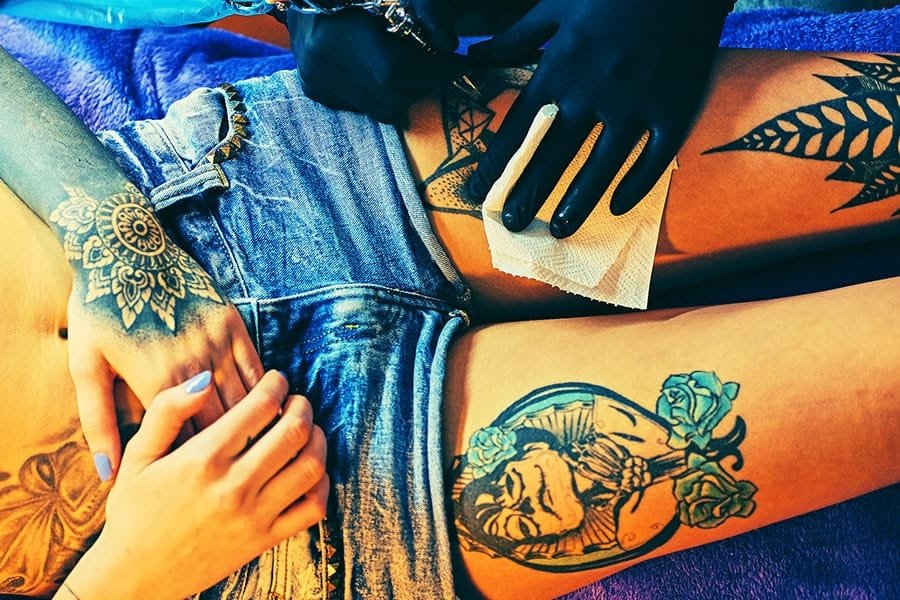Tattoos: A deeper and more chromatic expression of oneself
Introduction
A tattoo artist creates unique body art on different parts of the body. The best process of colorful tattoo making involves modifying the dermis layer by inserting ink with a needle, changing the skin pigment. These artistic expressions can be temporary or permanent, depicting symbols, animals, or personal designs.
Tattooing dates back thousands of years, with evidence from ancient mummies and prehistoric markings in Japan, Africa, and the United States. Early tattoo methods used needles made from bone, steel, or wood, causing significant pain. Today, modern techniques have made tattooing more precise, comfortable, and skin-friendly.
Colorful tattoos are now a popular trend, especially among teens and young adults. People get tattoos to express themselves, declare love, or create beautiful designs on their skin. As the demand for vibrant tattoos increases, so does the need for the best process of colorful tattoo making to achieve stunning, long-lasting results. This article explores the essential steps for creating a colorful tattoo that truly stands out.
The Complete Guide to Creating Stunning and Lasting Body Art
- Choose the Right Artist
- Look for an artist with a proven track record of creating high-quality, colorful tattoos.
- Check their portfolio to ensure their style aligns with your vision for the tattoo.
- Read reviews from previous clients to get a sense of their skills and professionalism.
- Plan Your Design
- Research different styles and designs to find inspiration for your tattoo.
- Work with your artist to create a custom design that suits your preferences and unique style.
- Consider factors like color, shading, and placement to create a tattoo that truly stands out.
- Prepare Your Skin
- Before your appointment, make sure your skin is clean and free of any lotions or oils.
- If necessary, shave the area where the tattoo will be placed to ensure a smooth application.
- Getting the Tattoo
- The artist will use a needle to inject ink into the skin, typically working in small sections.
- The artist will add color and shading as they work, creating a layered and detailed design.
- Expect some discomfort during the process, but the length and severity will vary based on individual pain tolerance.
- Aftercare
- Follow your artist’s aftercare instructions to ensure the tattoo heals properly.
- Avoid exposing the tattoo to direct sunlight or water for an extended period of time.
- Apply ointment or moisturizer to keep the area hydrated and promote healing.
- Touch-ups
- After the tattoo has healed, schedule a follow-up appointment with your artist for any necessary touch-ups.
- Touch-ups are typically needed to add detail or correct any fading that may occur over time.
- Maintenance
- As your tattoo ages, proper maintenance is key to keeping it looking its best.
- To avoid sun-induced fading, wear sunscreen.
- Keep the area moisturized, and avoid scratching or picking at the tattoo.
Short Summary
In conclusion, creating a colorful tattoo that looks great and lasts a long time requires a combination of research, planning, and proper aftercare. By choosing the right artist, planning your design carefully, and taking care of your skin before and after the tattooing process, you can create a colorful tattoo that truly reflects your style and individuality.
Modern Tattoo-Making Process
Renowned tattoo artists undergo professional training and gain practical experience in creating tattoos. They have a deep understanding of tattoo artistry and techniques. Tattoo parlors are increasing in number and popularity. With the finest body designs, convenient procedures, and professional approach, the tattoo industry is on the rise.
Before making a tattoo, the artist and the client first choose the design and placement. After finalizing the details, the artist uses a needle to draw the tattoo outline on the skin and seeks the client’s confirmation. After this, the process begins. At first, the artist uses an electric tattoo machine and places different types of ink and pigment into the dermis layer of skin, right under the epidermis (top-most layer of skin). The artist uses a single needle or a group of needles attached to a bar and connected to an oscillating unit. These needles move in and out of the skin at a speed of 80 to 150 times per second. For colored and shaded tattoos, the artist injects thicker needles.
After the artist makes the first injection, the pigment spreads through a homogenized damaged layer, reaching the epidermis and upper dermis. These layers contain foreign particles that activate the immune system’s phagocytes. As the artist inserts the needles, the phagocytes consume the pigment particles.
With healing, the injured epidermis gradually flakes away and removes the surface pigment. Granulation tissue is formed in the deeper skin layers and, through collagen growth, is converted to connective tissue. The upper dermis mends, and the pigment remains surrounded by fibroblasts. Finally, the pigment concentrates in a fine layer, just beneath the dermis or epidermis boundary. Initially, it’s stable; however, with time, it goes deeper into the dermis region and forms the desired tattoo design.
Safety Measures during the Process
While developing a tattoo on any part of the body, there are certain safety measures to look for:
Tattoo artists need to disinfect their hands with soap before initiating the process. They must maintain healthy standards of cleanliness and proper maintenance. Clean and sterilized tattoo equipment, preferably in a certified autoclave, shall be used for the process.
- Tattoo painters should clean the skin using an antiseptic and evenly apply petroleum jelly for painless and effortless procedures. While doing so, they must also put on gloves and wear masks.
- The wound must always be wiped with a wet tissue or a wet disposable towel.
- Tattoo candidates must ensure that they are physically fit and healthy before creating tattoos on their skin. Often, the skin type interrupts such procedures. At other times, certain health disorders, especially allergies, heart problems, and diabetes, don’t allow tattoo piercing.
Ways to Take Care of Tattoos
After crafting a tattoo, it is important to maintain it in the long run. Here are the ways of post-tattoo care and maintenance:
- Firstly, candidates must give time to the tattooed region for healing. They must keep the bandage, at least for a day, and refrain from touching the area until it heals completely.
Soon after tattooing, the specific skin area must be kept away from water. Also, people must not rub it, since rubbing will fade the tattoo. - Tattoos must be left in a moist state. If allowed to dry, it might form a thick coating. Drying out also slows down the recovery process, so the skin takes more time to heal.
- Tattoos can be showered regularly, but not soaked.
- People must never expose their tattoos to sunlight directly, at least for two weeks from the day of tattoo creation. This is because UV rays cause damage to the skin and fade the color of tattoo art.
- Post-tattooing and excessive workouts should ideally be avoided, especially if tattoos cover larger areas of skin like the elbows and knees. Working out breaks the tattooed skin and elongates the healing procedure.
- In addition to these, clients must always seek advice from their tattoo professionals about the best ways to care for their skin paintings. Since each skin type and tone is different, specialized care and maintenance help retain the quality, look, and feel of tattoos for eternity.
Conclusion
To sum up, modern tattoo-making procedures are more efficient, convenient, and comfortable. These are safe for the skin and do not affect health. The very desire to make a tattoo is quite encouraging, and people should move forward to fulfill it. However, they must be careful while selecting the tattoo parlor. A background check is the best solution. Overall, tattooing is a growing trend, and with innovative designs and emerging concepts, these are becoming more prevalent across societies.
If you are looking for the best tattoo removal, there are various tattoo removal surgeries and techniques wherein Care Well Medical Center can remove your tattoo(s) with safety and without much pain.
- Dermabrasion
- Dermabrasion followed by Melanocyte Treatment
- Skin Grafting Technique
- Excision
- Q Switch
- CO2 fractional laser









